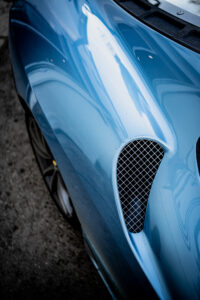The Ferrari 430 Scuderia sits in the middle of a trinity of lightened, track-oriented Ferrari V8 berlinettas, and often feels overlooked. Does it deserve to share more of the spotlight?
‘Stable’, as in a building you keep horses in. That’s how scuderia translates from Italian. Of course, the word has been subsumed into the world of motorsport by numerous Italian racing outfits, most famously the one whose crest is a rampaging stallion set against a yellow background. At face value, though, it’s still an odd thing to name a car – imagine if Aston Martin announced a stripped-out Vantage called the ‘Barn’.
That was the name Ferrari went with, though, for the hardcore version of its F430, an unequivocal statement of its racetrack bias, underlined by the heavily publicised involvement of one M. Schumacher in its development. Unveiled in 2007, the 430 Scuderia (yes, they dropped the ‘F’ from the name) arrived at something of a high point in the pantheon of more driver-focused sports cars. In contemporary group tests, it duked it out with the likes of the Lamborghini Gallardo Superleggera, 997 Porsche 911 GT3 RS and Mercedes CLK55 Black Series, all cars that could quite reasonably be considered ‘modern classics.’
When you look retrospectively the Scud’s close relatives, though, it doesn’t immediately seem like a headline act. Its predecessor, 2003’s 360 Challenge Stradale, helped invent the genre, together with the 996 GT3 RS. Then there was what followed – 2013’s 458 Speciale, a last gasp for the atmospheric Ferrari V8 with more five-star reviews than the entire discography of the Beatles, and a soundtrack to match.
This means that the Scuderia, while hardly forgotten, does sometimes feel a little like the awkward middle child compared to the trailblazing elder sibling and the overachieving younger one.
The Scuderia arrived at a tipping point for high-performance cars, when pure mechanical grunt was beginning to give way to the influx of digital technology that defines present day machines. As such, a car that was viewed as a technical powerhouse when new now has some pleasingly old-school appeal.
At launch in 2007, much was made of the gearbox’s ability to bang out changes in 60 milliseconds. Then there was the little manettino dial on the steering wheel, which switched between all the finely adjustable traction and stability control settings, from ‘make you look like a hero’ to ‘prove that you’re definitely not one’.
That gearbox, though – a single-clutch, six-speed paddle-shift affair – now looks completely outmoded in the face of modern-day dual-clutch systems and their seamless shifts. As for the engine? It’s a 4.3-litre version of Ferrari’s F136 flat-plane crank V8, developing its peak of 503bhp at an intoxicating 8,500rpm. Given that the 430’s descendants moved on to turbocharged V8s and then a V6 plug-in hybrid setup in the 296 GTB, it’s a reminder of an era that feels so recent and yet so deeply rooted in the distant past.
The interior also hails from an era when function was probably given more thought than form in supercars, especially those with a track-focused remit. The inside of the Scuderia has shed all but the most essential creature comforts, with plenty of bare carbon and aluminium on display. None of it has aged too well, although the steering wheel looks refreshingly uncluttered next to the overly complex units fitted to modern Ferraris.
Ferrari is a brand with a whole lot of cars that could be considered iconic – amongst the F40s, 250 GTOs, Daytonas and Speciales, it can be hard for some to stand out from the crowd. It’s harder still for the Scuderia, lacking some of the exclusivity of its predecessor and sheer, era-closing brilliance of its replacement. What it represents, though, is arguably the exact point at which the old Ferrari met the new – a watershed moment in the company’s history.



























